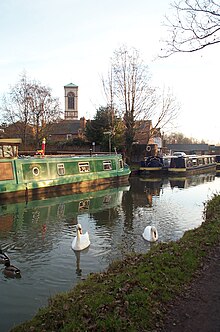Jericho, Oxford
| Jericho | |
|---|---|
 Jericho and the tower of St Barnabas Church seen from the Oxford Canal |
|
| Jericho shown within Oxfordshire | |
| OS grid reference | SP504069 |
| Civil parish |
|
| District | |
| Shire county | |
| Region | |
| Country | England |
| Sovereign state | United Kingdom |
| Post town | Oxford |
| Postcode district | OX2 |
| Dialling code | 01865 |
| Police | Thames Valley |
| Fire | Oxfordshire |
| Ambulance | South Central |
| EU Parliament | South East England |
| UK Parliament | |
| Website | Oxford City Council |
Jericho is an historic suburb of the English city of Oxford. It consists of the streets bounded by the Oxford Canal, Worcester College, Walton Street and Walton Well Road. Located outside the old city wall, it was originally a place for travellers to rest if they had reached the city after the gates had closed. The name Jericho may have been adopted to signify this 'remote place' outside the wall.
This was originally an industrial area which grew up because of its proximity to the Oxford Canal, which arrived in 1790. The Eagle Ironworks (now redeveloped into apartments), wharves and the Oxford University Press were based there and its residential streets are mostly 'two-up, two-down' Victorian workers' houses. With back streets of 19th century terraced housing and many restaurants, it has become a popular area for student and London commuter accommodation.
Many reports from the 1870s suggest that early homes in Jericho were built with very poor drainage. Low-lying land and lack of basic drainage in these homes would result in flooding. Flooding, open sewers, and overcrowding resulted in deaths from diseases such as typhoid and dysentery, with five out of eleven typhoid deaths in 1873 originating from Jericho.
In the 1950s, Jericho was briefly a red light area, and in the early 1960s there were plans to demolish it and replace it with light industrial units and new housing. However, many people objected and campaigned to save this historic area, rallied by local city councillor Olive Gibbs and the Jericho Residents Association. As a result, the plans were changed. Those houses beyond repair were demolished, but many others were upgraded in the late 1960s and early 1970s with the help of council grants. This encouraged many young professionals and families to move in; and subsequently Jericho became one of Oxford's most sought-after areas. Large council and social housing developments were built in the 1970s and 1980s.
...
Wikipedia

